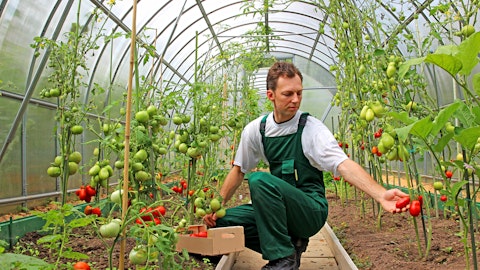Benson Hill, Inc. (NYSE:BHIL) Q4 2022 Earnings Call Transcript March 13, 2023
Operator: Good morning. Thank you for attending Benson Hill’s Fourth Quarter and Full-Year 2022 Earnings Call. My name is Harry, and I’ll be your moderator. All lines are on mute for the presentation portion of the call, with an opportunity for questions-and-answers at the end. And I’d now like to pass the conference over to your host, Ruben Mella, Senior Director, Investor Relations, with Benson Hill. Ruben, please go ahead.
Ruben Mella: Thanks, Harry. and good morning. We appreciate you joining us to review our fourth quarter and full-year financial results and our outlook for this year. With me today are Matt Crisp, Benson Hill’s Chief Executive Officer; and Dean Freeman, our Chief Financial Officer. Earlier this morning, we filled our earnings release and Form 8-K. These documents, as well as an investor presentation we will reference during the prepared remarks, are available on the investors section of the Benson Hill website. Comments today from management will contain forward-looking statements, including Benson Hill’s expectations of future financial and business performance, industry outlook, as well as current guidance for 2023 annual results, 2025 financial targets, and our plans and goals as we execute our strategy.
Forward-looking statements are inherently subject to risks, uncertainties and assumptions, and are not guarantees of performance. We caution you to consider these risk factors that could cause actual results to differ materially from those in the forward-looking statements. Such factors include those referenced in the cautionary note included in our press release and investor presentation, and that will be included in our Form 10-K, and other filings with the SEC. Also, during this presentation, we’ll be discussing certain non-GAAP financial measures. A reconciliation to GAAP is available on our earnings release and presentation. I will now turn the call over to Matt.
Matt Crisp: Thank you, Ruben, and good morning, everyone. 2022 was a remarkable year of progress for Benson Hill. We demonstrated the efficacy of our growth playbook to expand our reach in the human food and aquaculture markets, driven by consumer demand for better food choices. I continue to be impressed with our team and what they have accomplished as we leverage our technical capabilities through CropOS to partner with customers in a novel way. We continue to gain insights into which opportunities warrant the greatest focus to optimize the ingredient product mix for profitability, while maintaining operational excellence. As I look back on 2022, I want to highlight three important milestones among several that position us for future growth.
First, we executed our closed-loop business model for our soybean-derived ingredient products from farmer partners to our integrated soy processing facilities to our customers, all within 12 months, which is a credit to the teams involved. This further demand for a proprietary soy portfolio, which led to nearly 100% year-over-year proprietary revenue growth to $73 million. And as a result of this demand, operational excellence, and an elevated commodity pricing environment, we raised our ingredient segment guidance twice from the original outlook we gave this time last year. Second, we introduced our ultra-high protein soy ingredients with differentiating value propositions of traceability, sustainability, accessibility, being domestically sourced, and having higher nutrient densities.
And as a result, we established important commercial relationships, including a significant licensing partnership with market leader ADM, validating our technology and go-to-market capabilities that we have previously discussed. Third, at our Investor Day in 2022, we unveiled a robust product pipeline to demonstrate how we expect our CropOS technology platform to extend our leadership and delivering innovative product solutions to meet increasing demand for better food options. We will talk about recent advancements in the pipeline at our upcoming Investor Day on March 29th. As we announced on February 2nd, we expect 2023 will be another year of strong growth, with a 40% to 50% increase in proprietary revenues, to a range of $100 million to $110 million, as we continue to shift the mix away from non-proprietary commodity soy in our closed-loop model.
We believe consumer-driven secular trends are tailwinds for our proprietary soy flour, flake, and texturized products across plant-based market segments such as bakery, cereal, meat extension, and alternative meat. We are pleased with our partnership with Denofa, which gives us access and scale to service aquaculture customers such as BioMar, one of the largest aqua feed suppliers in Europe for ultra-high protein and low oligosaccharide meal. We are already sold out for 2023, and we are in discussions now about shipments for next year. We’re also nearly sold out of our Veri brand cooking oil for 2023, which is our high-oleic, low- linoleic, non-GMO soy oil product, after we increased planted acres last season beyond our original plan to meet demand.
We entered this year fully engaged with ADM, after initiating our strategic partnership last August to create exciting new advancements in food innovation through the introduction of product categories with novel advantages, while unlocking capacity with existing soy ingredient products. We recently achieved the first of what we anticipate will be many milestones with ingredient production from our portion of our 2022 ultra-high protein crop at ADM’s Decatur, Illinois facility. Our teams are currently collaborating on a co-branding strategy to launch a portfolio of new soy ingredients powered by Benson Hill, to ADM’s broad and established customer base. These examples of our commercial success, among many, demonstrate the demand side for a broad range of current and expected future products.
When we spoke to you on the third quarter call, we were ambitiously pursuing acreage for the upcoming growing season across all of our proprietary meal and oil product categories to achieve our 2025 targets. At that time, we began to see a pattern emerge, with delayed decisions by farmers, especially in our discussions with potential new farmer partners. That pattern has continued as commodity prices remain at elevated levels, which required us to significantly increase premiums to secure farmer commitments. In addition, inflationary pressures and supply chain challenges, has significantly increased product cost. Our highest margin products can take the increased cost with some margin compression, but we have other product categories at lower margins that cannot, and which would’ve put at risk our plans to reach our desired margin targets and profitability in 2025.
As I mentioned to you at our last Investor Day, we are committed to growing Benson Hill in a responsible way that meets the commitments to our farmer partners and customers, by expanding margins and appropriately managing our working capital. With that in mind, we made the decision to employ a more targeted growth strategy, focused on our highest-margin product categories to meet the specific needs of our customers, while de-emphasizing, but not eliminating, products that are now more exposed to margin compression. The 2023 planting season will expand as we planned, our ultra-high protein food ingredients, soy meal for the aquaculture market, and the highest margin oil products. To support our goals for continued gross profit and margin expansion in 2024, we did not pursue acreage for certain soy flour, flake, and oil product categories.
In addition, we are offering farmers several new proprietary varieties this year, with higher yields and expanded maturity planting zones. Over the next two to three years, we expect to introduce additional next-generation pipeline products that not only offer our customers more value, but gives farmers increasingly better performing seed varieties that allow us to optimize unit costs well beyond 2025. Given this more focused approach, we expect total planted acres, including new acres secured with ADM, for the 2023 crop season will increase by approximately 50% of the original plan, instead of the original plan to double planted acres. The collaboration with ADM is giving us the opportunity to begin expanding our network with quite a few new farmers in Illinois, with harvest that will be processed at ADM’s Decatur facility.
These farmers are joining our network to connect more directly what they grow with the consumer. We completed our annual budget and long-range planning process based on our more focused growth strategy. We remain committed to achieving our target of positive adjusted EBITDA and positive free cash flow in 2025. We believe the de-emphasis of certain lower margin products will defer the previously planned proprietary revenue contribution beyond 2025, at which time we would expect commodity prices and operational cost pressures to normalize. Similarly, we tempered the revenue recognition for the ADM partnership, and the timing for securing new partnerships for a more conservative view, given the current environment. For these reasons, we are now projecting 2025 proprietary revenues to be at least $300 million.
Total revenues are targeted to be over $400 million, which excludes projected revenues from the sale of the Fresh business. We remain committed to achieving gross margins of 25% with this more targeted approach to the market, and other plans to optimize our closed-loop model that Dean will address shortly. I will conclude by saying that we’ve demonstrated the ability to adapt in the face of shifting macroeconomic and market conditions. Our foundation is the talent that we have at Benson Hill, who creates the value-added ingredient innovations we offer our customers, starting from the beginning with a better seed. We’re off to a strong start in 2023, and expect our first quarter results to be indicative of the momentum we experienced last year.
We are eager to work with our farmer partners for the upcoming growing season, fulfill repeat and new orders from our expanding customer base, and continue to advance our pipeline of future product innovations. We’re putting the final touches on our Investor Day here in St. Louis for March 29th. Our objective is to build on what you learned last year, and offer an immersive experience around the future of food. We want you to leave with a clear representation of not only why Benson Hill wins, which is the theme for our Investor Day, but also a deeper understanding of how we are living our mission to set the pace of innovation in food. I’ll now turn the call over to Dean for his perspective about our fourth quarter and full-year performance, as well as our outlook for 2023 and plans to further strengthen the balance sheet and reduce our cost to capital.

pablo-merchan-montes-Orz90t6o0e4-unsplash
Dean Freeman: Thanks, Matt, and good morning, everybody. Let me just start with a couple comments about Silicon Valley Bank. Benson Hill does have a relationship with Silicon Valley Bank, and we’ve had that relationship for many years. We took quick actions to minimize the impact of last week’s events on our farmer partners, our vendors, our customers, and our employees. We currently have approximately a little over $7 million in accounts with Silicon Valley Bank, with about $6 million of that in sweep accounts where the funds are in custodial investment funds held by third parties on behalf of Benson Hill. As of last night, at about 6:15 p.m., the FDIC issued a press release communicating that all deposit holders will have access to their funds as early as today.
We’ll wait for further instructions on that, and as of this morning, that was the only update we really have received. So, while we wait further instructions on access to our funds, I want to reinforce that this situation will not have, has not had, any impact on our ability to meet all of our financial obligations. As I review the financial results, keep in mind that our performance excludes the Fresh business, which is now reported as discontinued operation. We’re on track to complete the sale of the business in the second quarter of this year, and receive the remaining $3 million from the $21 million transaction. It’s worth repeating what Matt said about how well our operations and commercial teams performed in 2022. It would take too long to list the activities needed to not only stand up the closed-loop business model with newly integrated assets, but also realize the significant efficiency gains that led to several months production records in the second half of the year.
The strong execution from our teams allowed us to take advantage of high commodity prices to deliver non-proprietary topline growth in 2022 that was well ahead of our expectations. More importantly, we’re well positioned in 2023 to continue the plant transition to produce more proprietary soy products. As a result, our consolidated revenue guidance is $390 million to $430 million, which includes our expectations for proprietary revenue growth that Matt mentioned earlier. As I’ve said before, we’re not immune to the challenges posed by increasing inflation and supply chain dislocations, primarily related to logistics. Our teams kept finding ways to move finished goods in the face of unprecedented factors, such as the threat of national rail strike, ongoing availability of rail cars, installed barge traffic due to record low water levels in the Mississippi River.
Additionally, we had to address higher operating costs and labor shortages. These higher costs were a factor in December, which impacted our fourth quarter cost of sales by approximately $1 million. Other factors affecting gross profit were an approximate $1 million of non-cash charge for the step-up of assets related to the Creston acquisition. And finally, we took delivery of more proprietary bean deliveries than expected, which resulted in a larger-than-planned recognition of already incurred seed production costs worth about another $1 million. These unusual items were the primary cost for our full-year gross profit of $8.5 million, which excludes approximately $5 million loss due to mark-to-market timing differences coming in below our previous guidance.
As we look to 2023, we expect gross profit to more than double to the range of $20 million to $30 million. This will be driven by the plan increase in proprietary revenues, an expected increase in year-over-year profit contribution from the ADM partnership, and contributions from the non-proprietary side of the ingredients business. Our guidance also considers the impact of the persistent inflationary environment. We remain laser-focused on cost discipline, while still supporting our strategic objectives. Operating expenses in 2022 were $129 million, which was within our guidance. When you adjust for approximately $9 million of operating expenses for the Fresh business for 2023, we expect operating expenses to be in the range of $125 million to $130 million, which includes approximately $30 million in non-cash depreciation and stock compensation.
Turning to adjusted EBITDA, we realized a loss of $77 million in 2022, which was within our guidance when excluding mark-to-market timing differences. With an increase in gross profit and continued cost management discipline, we expect a reduction in the 2023 adjusted EBITDA loss in the range of $63 million to $68 million, as we announced last month. As of December 31, we had $175 million of available cash, restricted cash, and marketable securities. Consistent with our plans, we began a two-year $28 million capital project to add texturization capabilities to our Creston facility, which led CapEx in 2022 at the top end of the original $12 million to $16 million range, including approximately $9 million in capital expenditures for the Fresh business.
This anticipated high ROI investment will allow us to produce texturized soy flour from multiple product applications at a significantly lower production cost compared to third-party tolling. For 2023, we forecast capital expenditures to be in the range of $20 million to $25 million. We remain opportunistic in pursuing to optimize Benson Hill’s capital structure. To that end, we are in the advanced stages of finalizing plan that by as early as the third quarter this year, will enable a conventional lending facility with the syndicated banks for up to $100 million. The structure of the facility is planned to consist of a line of credit, equipment loan, and term loan. The expected borrowing costs would reduce interest expense by approximately 40%.
We view the interest from these conventional lenders as the validation of our ingredient innovations, go-to-market strategy, and cash generation potential. With the expected funds provided through the new loan facility, which we anticipate will be supplemented by up to $100 million of capital raise under the current shelf registration statement, including the ATM facility, or an alternative form of equity financing. And to be clear, our expectations that any additional equity raise proceeds will be in lieu of proceeds sourced from the ATM. Our plan is to pay off existing high-cost debt facility two years earlier than planned. While we cannot guarantee anything regarding the new lending facility, the negotiations to finalize it are far enough along, and we have confidence that the successful completion will lower our cost to capital, give us greater flexibility to meet our strategic objectives.
The plan I just outlined will include prepayments and other costs. The capital project, which is central to our strategy, and the one-time cost for the refinancing, are expected to total between $30 million and $35 million, and our significant contributors to the expected greater free cash flow loss in 2023 in the range of $120 million to $128 million. We’ll continue to keep doing what we’ve been successfully doing, scale the proprietary portfolio for margin enhancement, deliver operating efficiencies, and maintaining strong cost discipline. This is the foundation that we anticipate will lead to continued and significant reductions in our free cash flow burn in 2024, and position us with momentum to positive free cash flow in 2025. Another element of our plan is to further improve capital deployment in our closed-loop operations for higher return on capital and reduced working capital intensity.
Therefore, we’re now exploring strategic alternatives for our facility in Seymour, Indiana, which may include, but is now limited to, the sale of the asset. The team at Seymour is doing a terrific job operating at record-breaking production levels. The capacity we now have access to, through our partnership with ADM, our Creston Iowa facility, and the ability to source capacity through partner tolling arrangements, gives us the opportunity to reassess the capital intensity of our closed-loop manufacturing footprint. I’ll conclude by saying, we are taking the necessary actions to address the current market realities, and we remain optimistic about our outlook today and into the future. We believe the pieces are in place this year to continue the scaling of our proprietary portfolio, and by focusing on the highest margin product opportunities, we expect to successfully navigate the peak of the commodity cycle, inflationary pressures, and the ongoing logistics challenges.
The actions we’re taking to optimize our capital structure are consistent with our strategy and path to achieving our targeted financial objectives in 2025, and our expectations for profitable growth in the years to follow. And with that, I’ll conclude my prepared remarks, and we’ll take your questions.
See also 15 Countries with Highest Inflation Rates and 20 Most Important Companies in the World.
Q&A Session
Follow Benson Hill Inc.
Follow Benson Hill Inc.
Operator: Thank you. And our first question of the day is from the line of Ben Theurer of Barclays. Ben, please go ahead now.
Ben Theurer: Yes, good morning, Matt, Dean. Congrats on the results. Two questions. So, first one, obviously, you have a very good outlook for growth on the proprietary side, but you also mentioned a couple of challenges just with farmers and getting them signed up. So, maybe help us understand little bit what you’re agreeing on with farmers and how you actually managed to sign farmers up, just given the comments you made, to still see call it a roughly 40%, 50% growth on the proprietary side into next year, so we can kind of get a sense on how we should think for the years after on the signup right here. That would be my first question.
Matt Crisp: Sure. Hey, Ben, it’s Matt. When we look at the market dynamics for signing up growers to grow non-GMO identity preserved beans. A few things are happening this year. Obviously, we’ve got really high commodity pricing environment. We’re seeing a decline in non-GMO planted acres in the United States. And we’re seeing a fair amount of demand for your closed-loop production. The combination of those things has this year driven premiums to higher levels, and that’s okay for us to maintain profitability of the highest margin products, namely, as I mentioned, certain of our oil products and our UHP for human food category, as well as meal for the aquaculture feed category. But what it does is, it compromises the profitability of some of the other parts of the portfolio.
And so, what I’d say is, we made a very conscious decision to sign up the acres with the varieties to produce the products that we need in order to meet those demands that we feel confident have a profitability profile that increases our gross margin expansion the way that we’ve planned. But when it came to some of these premium levels with farmers, we made the conscious decision not to pay them in some cases where we felt like this was going to be compromising the output. So, there’s a high confidence that we could have signed up substantially more acres, but I don’t think that that would’ve been the responsible thing to do, nor were we in a position where we needed to break any contracts. In other words, we’re able to meet all of our contractual obligations, but it’s always a state of marrying what our demand side needs are, looking out two years from now, to what would ultimately be sales in 2024, and backing into how we’re optimizing our seed variety mix at the farmer level.
Ben Theurer: Okay, perfect. And then my second question, I guess, that’s more for Dean. Can you help us understand, because if I look at the balance sheet, cash and cash equivalents shows up only at like $25-ish million, and marketable securities at 132, but then you say it was 175. So, the difference, first question. And the second is, the proceeds you received the first tranche of it for the Fresh business divestiture, is that reflected in that cash balance, or is that not yet reflected in the cash balance, just because of how the flows was, as it was just roundabout the closing of the year. Thank you.
Dean Freeman: Yes, so the 175 should include restricted cash. And as you point out, our total cash balance is restricted cash, cash and marketable securities, and cash on hand. So, for the end of December, that should be 175.
Ben Theurer: Okay. And does it include the proceeds from the Fresh sale or not yet?
Dean Freeman: Yes, it does. Yes.
Ben Theurer: Okay. Thank you.
Operator: Thank you. Our next question is from the line of Kristen Owen of Oppenheimer. Kristen, please go ahead now. Your line is open.
Kristen Owen: Great. Thank you. Good morning, everyone. I was wondering if you could start by just walking us through the puts and takes on the decision around the Seymour facility. What are the trade-offs that you’re considering for that facility specifically? And are there maybe some opportunities outside of just outright selling it? I’ll start there.
Matt Crisp: Sure. Hi, Kristen, it’s Matt. And for Seymour, what we evaluated was what the working capital intensity is of the business relative to our need to meet the demands for the proprietary revenue growth. And with a slightly tempered proprietary revenue growth profile and the product mix that we see being optimized, we feel that this is an opportunity for us to create some additional liquidity less working capital intensity, and still maintain the relationships with some of our farmer partners that we feel are really critical to meet the demand that we have. So, the expansion of our footprint into Illinois with the ADM relationship, the augmentation of additional third-party crushing and tolling relationships, combined with the backbone of our food grade ingredient production at Creston, we felt as adequate for us to meet the needs that we have in the foreseeable future.
And so, again, in the interest of focusing our growth profile and ensuring that we maintain our commitment to shareholders to be profitable in 2025, we felt this was an opportune time to consider other strategic alternatives for that asset.
Dean Freeman: Yes. Kristen, let me just add and maybe reinforce a couple comments that Matt made. In the first consideration is the capacity to meet our customer requirements as sort of the first stop. As we assess and rationalize sort of the portfolio in terms of non-proprietary ingredients, it’s clear that we have the adequate capacity to meet the demand, as Matt mentioned, with both the Creston facility, as well as the options we have with regard to the Decatur facility, and our partnership with ADM. The other part of it is the working capital intensity. I mean, as you kind of think about the trade-offs between higher volumes, lower margins, and the capital usage to support that, that trade-off became a point where we felt we could continue to optimize that with this decision.
And so, as we think about continuing to optimize the capital structure being capital allocation-disciplined, but also meeting the demands of our customers with higher levels of profitability, it made sense to consider these options.
Kristen Owen: No, that’s really helpful. Thank you for that, Matt, and Dean. Just as a follow -up and thinking about some of the updated 2025 expectations, what you’re seeing in the marketplace today, we’ve talked historically about what the trend in margin looks like as you increase the percentage of proprietary revenue, but I’m wondering if you can help us bridge on the revenue line, how we get to your updated 2025 numbers, given some of the mix shift that you’ve discussed. Thank you.





